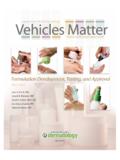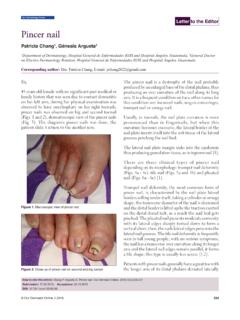Transcription of Update on Prevention and Treatment of Diaper Dermatitis
1 Given that pediatricians treat approximatelythree-quarters of all children who see aphysician for Diaper Dermatitis and that dia-per Dermatitis is considered the most com-mon dermatologic disorder of infancy,1it is practi-cally guaranteed that you treat several cases perweek. Precisely because Diaper Dermatitis is such acommon condition and often distressing for infantsand parents, a review of Treatment and preventionoptions is and CausesThe most comprehensive analysis of Diaper dermati-tis trends is now several years old,1but it offers asnapshot of the disease, which was found to accountfor million outpatient visits in the eight-yearperiod form 1990-97. Based on the survey, infantsare estimated to have a one-in-four chance of devel-oping Diaper Dermatitis .
2 Most patients (75 percent)presented to a pediatrician for that contribute to the development of dia-per Dermatitis are moisture, friction, excrement, andin some cases peak for inci-dence of Diaper Dermatitis is in the second half ofthe individual s first year through about 18 monthsof age. Increased mobility of the child accounts forthe friction that contributes to Diaper also assumed that changes in diet through the sec-ond half of the child s first year may also modulatefecal pH, thus influencing the contribution of fecalskin exposure to the formation of Dermatitis . It hasbeen shown that exclusively breast-fed infants hadlower rates of Diaper Dermatitis compared to formu-la-fed infants. Breast milk consumption is associatedwith higher fecal pH, further suggesting an influ-ence of diet on fecal pH and Diaper Dermatitis role of urine in causing Diaper Dermatitis isnot simply the contribution of moisture.
3 In the pres-ence of fecal urease, urea is broken down, producingan increase in pH that encourages activation of fecalproteases and lipases that damage the Prevention and TreatmentPractical strategies used to combat Diaper dermatitisinclude changing soiled diapers as quickly as possi-ble and using disposable diapers, which have beenengineered to absorb moisture into the Diaper andreduce moisture against the disposablediapers engineered with absorbent gelling materials(AGM) and microbreatheable materials appear to beassociated with a decrease in Diaper Dermatitis (Seesidebar).6,7 There is limited data comparing cloth dia-pers to older cellulose core disposable diapers andmodern AGM disposable diapers, but overall trendsfavor the new disposable they maybe associated with potential messes, air baths ( ,leaving the infant undiapered for periods of time toforego occlusion and allow the Diaper area to dry) Update on Prevention and Treatment of Diaper DermatitisOne of the most common cutaneous skin complaints in infancy can be avoidedwith old or new | Practical Dermatology for Pediatrics| July/August 2011By Joseph Bikowski, MDremain a worthwhile adjunct to other pediatricians well know, a whole market of barrier creams is available over-the-counter for thetreatment and Prevention of Diaper Dermatitis .
4 Thesevarious ointments and pastes are formulated withingredients such as petrolatum or zinc oxide that areintended to form a film to protect the skin fromexposure to moisture. It should be noted that barri-er repair creams, discussed below, are also now onthe market and are engineered differently fromthese Diaper creams. Curiously, there has been little controlled study ofover-the-counter Diaper Dermatitis preparations. A2005 Cochrane review found no conclusive evidencethat vitamin A ointments helped to prevent or treatdiaper Dermatitis , though there was no evidence recent survey of the literature found nocontrolled studies of zinc oxide pastes in infant dia-per Dermatitis . A small study of adult Diaper der-matitis demonstrated that application of an anhy-drous zinc paste reduced transepidermal water loss(TEWL), a sign of barrier dysfunction, andimproved stratum corneum (See side-bar.)
5 Coupled with the use of recommended Diaper -ing practices, the evidence and experience suggestthat these ointments and pastes may successfullymanage minor cases of Diaper Dermatitis and pre-vent of Moderate to Severe Diaper DermatitisModerate to severe Diaper Dermatitis confirmed orsuspected to be Candidainfected requires targetedtreatment. Topical corticosteroids are still recog-nized as a Treatment option for Diaper Dermatitis ,though their use for this indication is increasinglydiscouraged. The incidence of adverse events associ-ated with the use of topical corticosteroids increasesDiaper DermatitisJuly/August 2011|Practical Dermatology for Pediatrics| 17 Photo courtesy of Joseph Bikowski, Disposable DiapersAbsorbent gelling material (AGM), which is used in many dispos-able diapers for absorbancy, consists of cross-linked sodiumpolyacrylates that bind water in a gel matrix.
6 The AGM hasbuffering capacity to control pH, and its rapid absorption ratehelps to separate urine from feces. Diapers containing AGM are labeled as super absorbent, andare available from major manufacturers (such as Pampers,Procter and Gamble or Huggies, Kimberly-Clark), as well as manystore-brand versions of these products. Most also containbreathable fabric liners that further reduce contact between theskin and moisture. J Am Acad Dermatol. 1987 Dec;17(6) to the potency of the agent applied,11andocclusion as from a Diaper is shown to increasecorticosteroid potency. The risk for adverse eventsalso increases when topical corticosteroids areapplied to thinner skin, as in the Diaper , low potency topical corticosteroidsshould be reserved only for very inflamed dermati-tis that does not respond to other appropriate treat-ments, and the course of therapy should be Diaper Dermatitis typicallyinvolves the concave surfaces of the Diaper regionprimarily.
7 Involvement of the skin folds tends toindicate a Candidaand/or less commonly bacterialinfection. Beefy red plaques form with satellitepapules and of improvement withfirst-line Diaper Dermatitis therapies is another indi-cation of infection of secondary yeast appear to be the most frequent con-tributors to moderate to severe Diaper variants of Diaper Dermatitis includegranuloma gluteale infantum, a rare condition of unclear etiology characterized by asymptomaticcherry red nodules against the setting of primaryirritant contact even rarer variantis Jacquet erosive diaperdermatitis, characterizedby punched out ulcers orerosions with differentialdiagnosis of Diaper der-matitis may include sebor-rheic Dermatitis , psoriasis,bacterial infection (charac-terized by honey-coloredcrusts and superficial ero-sions)
8 , and contact der-matitis (CD), either allergicor irritant, to a componentof the Diaper or the skincare used topicalantifungals for the manage-ment of Diaper dermatitisinclude nystatin, clotrima-zole, and miconazole. In ahead-to-head trial, clotrimazole was found to besuperior to nystatin in terms of reduction in symp-tom score and Investigator Global Assessment, butboth agents achieved 100 percent a controlled trial of miconazole ointment, the rate of microbiological curewas 50 percent for active Treatment compared to 23percent for alternative treatmentoption is topical mupirocin, which was found toeradicate Candidaas well as nystatin did in a head-to-head trial but with more rapid clinical should be applied three to four times perday or at each Diaper change.
9 Recurrence Prevention Regular use of OTC Diaper ointments or pastes andfrequent Diaper changes are required for any patientwith a history of Diaper Dermatitis . The growing fieldof epidermal barrier repair devices may provide analternative approach to maintenance of infant skinhealth and Prevention of Diaper Dermatitis . Physicaldegradation of the epidermal barrier caused by expo-sure to excrement, moisture, and friction directly con-tributes to Diaper Dermatitis . Furthermore, reducedDiaper Dermatitis18| Practical Dermatology for Pediatrics| July/August 2011 Photo courtesy of Joseph Bikowski, pH is associatedwith a decrease in epidermalbarrier integrity, reduced antimicrobial defenses, andincreased barrier repair devices, formulatedwith ceramides and/or essential fatty acids, havebeen developed with the goal of supporting properepidermal barrier function and repair, which wouldthereby be expected to reduce TEWL, maintainskin pH, and improve antimicrobial , these agents, while not studied specifi-cally for the management of Diaper Dermatitis , maybe beneficial for use in infants with a history ofdiaper Dermatitis , specially those with recurrentpresentations.
10 Epidermal barrier repair creams areavailable over-the-counter (CeraVe, CoriaLaboratories; Restoraderm, Galderma) and by pre-scription (Atopiclair, Graceway; Eletone, FerndaleLabs; EpiCeram, Promius Pharma; Hylatopic Plus,Onset Dermatologics; Mimyx, Stiefel). Wrapping UpDiaper Dermatitis can be distressing for affectedinfants and their caregivers. Incidence of the conditionis high, and a given infant has a relatively high risk ofdeveloping a Diaper rash. Frequent Diaper changes anduse of newer disposable diapers may reduce the riskof Diaper Dermatitis . Use of over-the-counter diaperointments or pastes or alternatively the use of epider-mal barrier repair devices may also be Diaper Dermatitis almost alwaysrequires topical anti-Candidatherapy and rarely topi-cal corticosteroids.










